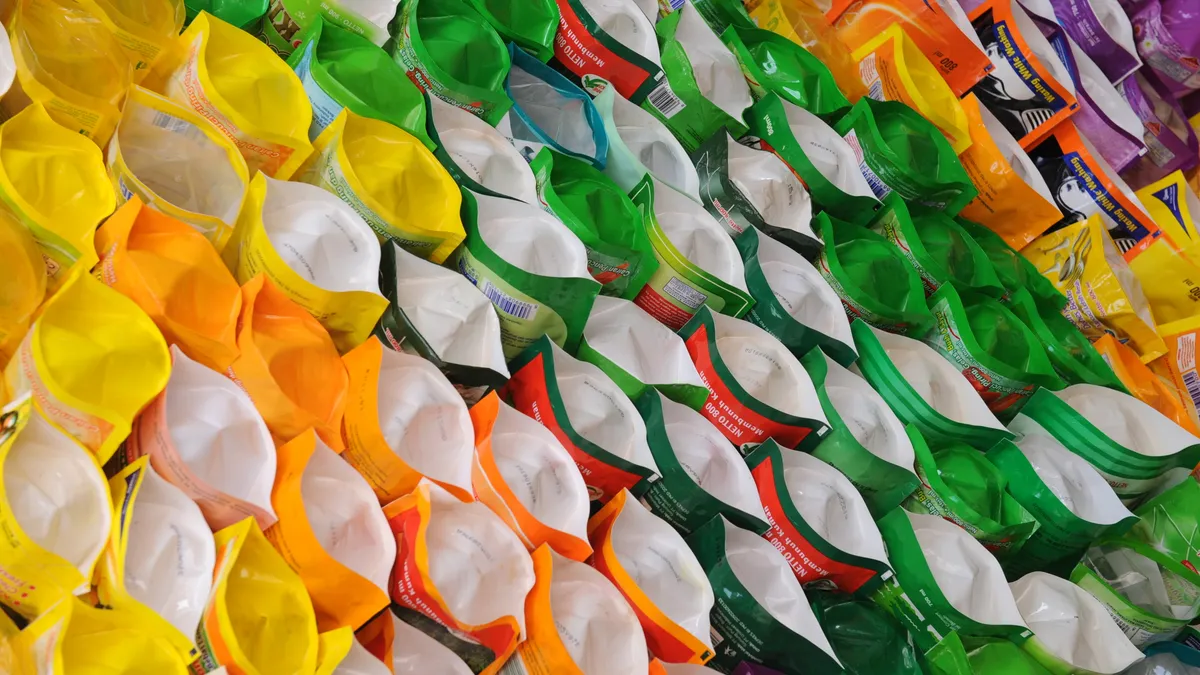Packaging automation is rocking ahead in 2021, and it's not just because of the pandemic.
Automated technology, in everything from robots to remote equipment repairs, has matured to the point that packaging automation is not just possible — it's a necessity to just keep up with the competition.
"Everything we talked about before COVID just became accelerated," said Alicemarie Geoffrion, vice president of packaging operations in North America at DHL Supply Chain. "If you have an operation that is heavily reliant on labor and something like COVID occurs, you have a weak link in the supply chain."
Automation is here, with room to grow
Secondary, or exterior, packaging is a prime target for automation because it's a continuous and repetitive task. In an October report on Secondary Packaging Trends by PMMI, an industry group representing packaging and processing technologies, 67% of brand manufacturers said that their end-of-line operations are already heavily automated.
But there's also room for automated growth, with 85% of manufacturers still looking to expand their current portfolio of automated solutions in secondary packaging, according to the report.
"Automation is certainly a necessity going forward, as this transition from brick and mortar to e-commerce balances out that channel delivery."

Scott Keefauver
Global Marketing Director in Fulfillment at Sealed Air
Much of that drive is coming from the profliferation of SKUs. Faster and shorter production runs have meant more SKUs, but that also means more production changeovers.
"Any changeover will slow down your line and will take down productivity," said Jorge Izquierdo, vice president for marketing development at PMMI. According to the report, 65% of consumer packaged goods companies said they would like to changeover lines faster through automation upgrades.
Automation in a booming e-commerce economy
The pandemic pushed forward a demand for e-commerce, which is not always the most effective, affordable or efficient delivery method in getting products to consumers. It's not as easy as shipping a bunch of the same product to a store for customers to pick up. But it's also not going away anytime soon.
"Automation is certainly a necessity going forward, as this transition from brick and mortar to e-commerce balances out that channel delivery," particularly in addressing inefficiencies with e-commerce fulfillment, Scott Keefauver, global marketing director in fulfillment at Sealed Air, told Supply Chain Dive last month.
"Because of the additional burdens placed on delivery to that process, automation is an answer to help address that," he said.
Sealed Air said it is serving a market that typically grows at 1%-3% a year, according to its Q4 2020 earnings report. It's looking to accelerate that growth to 2%-4% on its base business, and another 100 points with automation. About 40% of its capital expenditures is focused on growth, including breakthrough, production process, automation and digital.
This demand for automated packaging equipment has created its own backlog. Geoffrion said that lead times for equipment from vendors has gone from three weeks to 10 weeks.
"Everyone took a step back over the last 12 months and said, 'We need to make sure we protect our supply chain,'" she said.
Meeting a labor shortage
The PMMI report found that 21% of brand manufacturers said that some of their operations rely on human labor. This became a problem during the pandemic.
"Where before you were trying to have eight to 10 people on a packaging line, maybe you're trying to have four to five people," due to social distancing, said Izquierdo.
Staffing becomes inconsistent if people get sick or have to quaratine due to potential COVID-19 exposures. While extremely necessary for the health and safety of their worforces, it presented problems for manufacturers in keeping their production lines going.
Plus, manfacturing was already facing a labor shortage before the pandemic. The National Association of Manufacturers was ringing alarm bells in 2019 about a labor shortage exacerbated by gradual retirement of the baby boomer generation.
"There’s still aspects where manual labor allows you to be much more creative, sometimes making changes on the fly."

Alicemarie Geoffrion
Vice President of Packaging Operations in North America at DHL Supply Chain
Automated technology has matured, particularly with collaborative robots, called cobots, making it easier to fit automation into the packaging process.
The pandemic also made companies realize the potential for remote repairs, Izquierdo said. Service technicians and sales representatives were denied access to manufacturing floors during the pandemic due to safety restrictions. In September, that rejection rate hit 75%, he said.
"Because of that, the use of remote access has increased significantly," he said. Much of the equipment already installed came with remote technology, but it just hadn't been accessed before.
Geoffrion said that, while automating packaging helps keep the suply chain steady, humans will never disappear from the process, especially because brands still want to have flexibility in their packaging designs.
"There's still aspects where manual labor allows you to be much more creative, sometimes making changs on the fly," she said. "There are absolutely reasons you don't want to automate everything."
Matt Leonard contributed to this report.
This story was first published in our weekly newsletter, Supply Chain Dive: Operations. Sign up here.






















